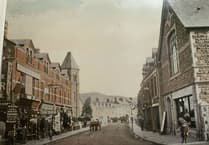ARCHAEOLOGISTS working in Abergavenny have found the first ever remains of a Roman road in the town.
The short section of ‘highly significant’ historic carriageway was found in the shadow of one of Abergavenny’s most important architectural treasures - the Grade Two Listed Gunter Mansion in Cross Street.
It was here in a secret Catholic chapel that the Jesuit priest St David Lewis - known as the last Welsh martyr - celebrated mass before his arrest and execution in 1679.
This happened after the Titus Oates plot when Catholics were accused of a conspiracy to assassinate Charles II and were forced to meet and hold their services in secret.
At the time the property was owned by Thomas Gunter, a local attorney and ardent supporter of the Catholic faith.
St David Lewis, born in Abergavenny in 1616, was canonized in 1970 by Pope Paul VI as one of the Forty Martyrs of England and Wales.
But possibly 1600 years before his death Roman occupants were settling in the town and building roads, other remains of which can be traced on the Hereford Road out of town
The town centre highway relic was uncovered by the Glamorgan-Gwent Archaeological Trust who had been commissioned to carry out a dig at the site by the Cardiff Exchange and Office Company Ltd. They had submitted a planning application to Monmouthshire County Council for a proposed domestic development at the back of the Gunter Mansion, now comprising shops at 34-39 Cross Street.
Historically, the front of the mansion faced the rear park and the scene of the dig. Today’s frontage on Cross Street is actually its back.
Archaeological advisors at County Hall had recommended that a decision on the application should be deferred until the site had been examined. It was felt there was a ‘high probability’ of encountering buried remains.
Five trenches were subsequently dug - and in Trench 2 the team of experts had their ‘eureka’ moment when they uncovered a short section of Roman road running north to south.
The archaeological team, in their report, said, “This is the first evidence of any Roman road within the town itself and is therefore of high significance.”
But that is as far as they got.
“Due to the physical constraints imposed by the site on the excavation of the trenches it proved impossible to recover further evidence on the alignment of the Roman road and/or any associated Roman features,” said the team.
But they did also find medieval and early post-mediaeval artefacts and structures which were ‘reflective of the town’s development beyond its medieval defensive walls.’
They expressed concern over the protection of their find.
“It is probable that any development that occurs in the areas of identified features will have an impact upon the buried archaeological resource,” they warned.
The discoveries have delighted the town’s local history society.
Former chairman and honorary life member Irena Morgan said, “It’s very exciting news for Abergavenny. It’s such an important find for the town…just wonderful.”
Tony Konieczny, chairman of the town’s civic society, said, “It is significant - but it would be so much better if further excavation work could be carried out to find out more about the road and anything else that might be interesting.
“An in-depth study would be good because once building work does start that chance will disappear for some considerable time.”
The planning application originally submitted to County Hall is currently invalid.
An MCC spokesman explained, “The application is for residential development of eight units comprising a one-bedroom flat, a two-bed flat above four car ports and six three-bedroom houses and all associated works.
“It was made invalid whilst further information was requested in relation to the archaeological surveys and viability assessments. However the application may be able to be re-registered shortly.”




